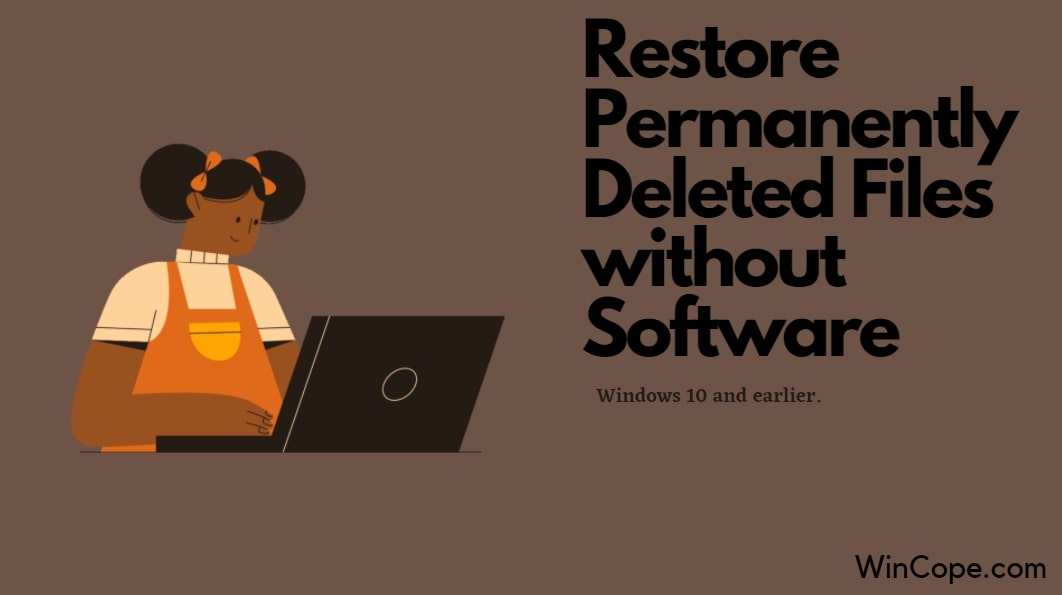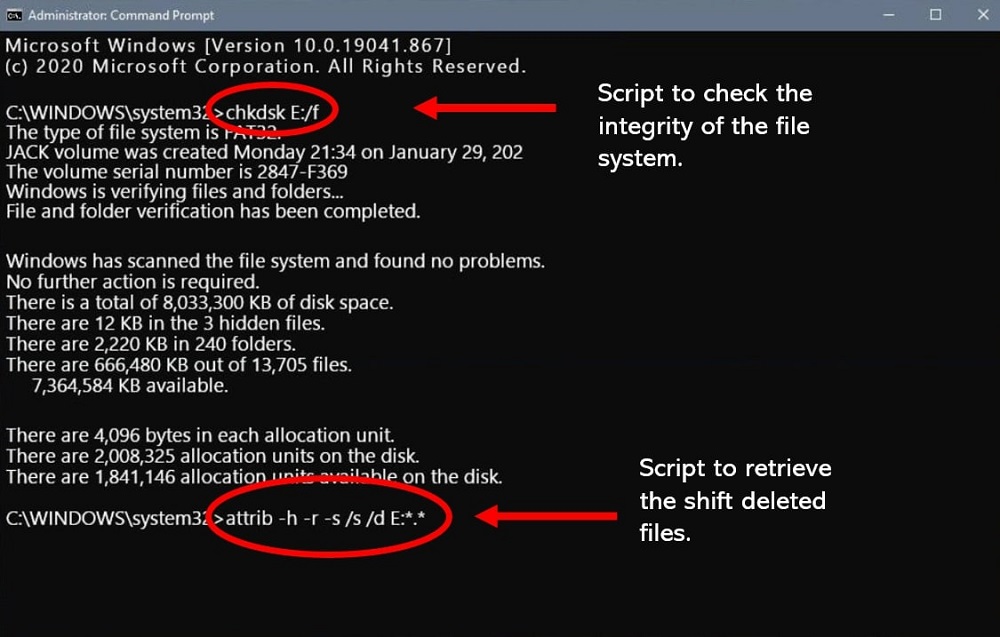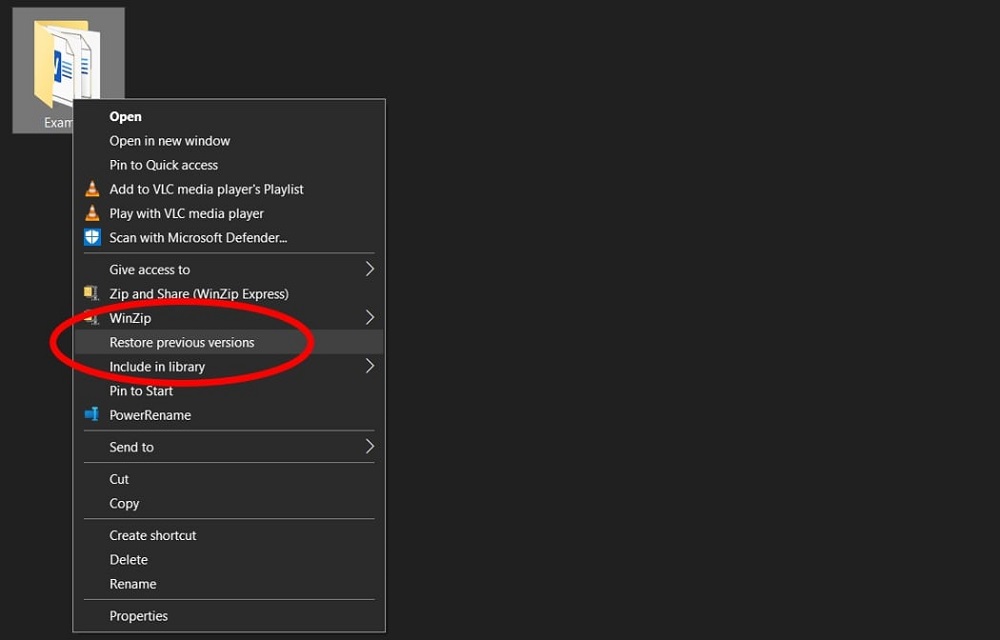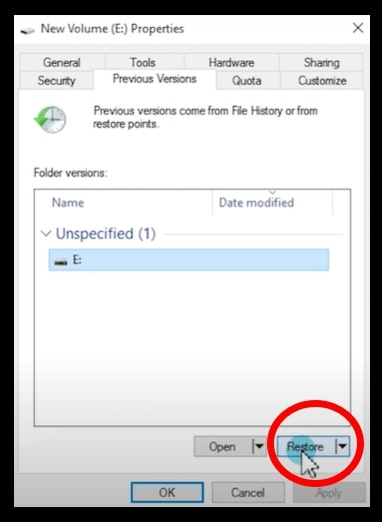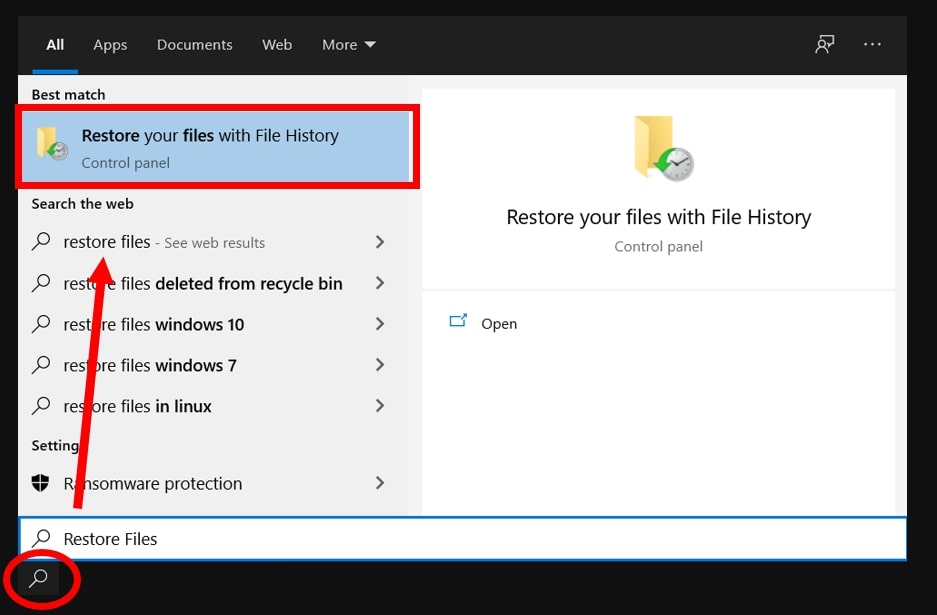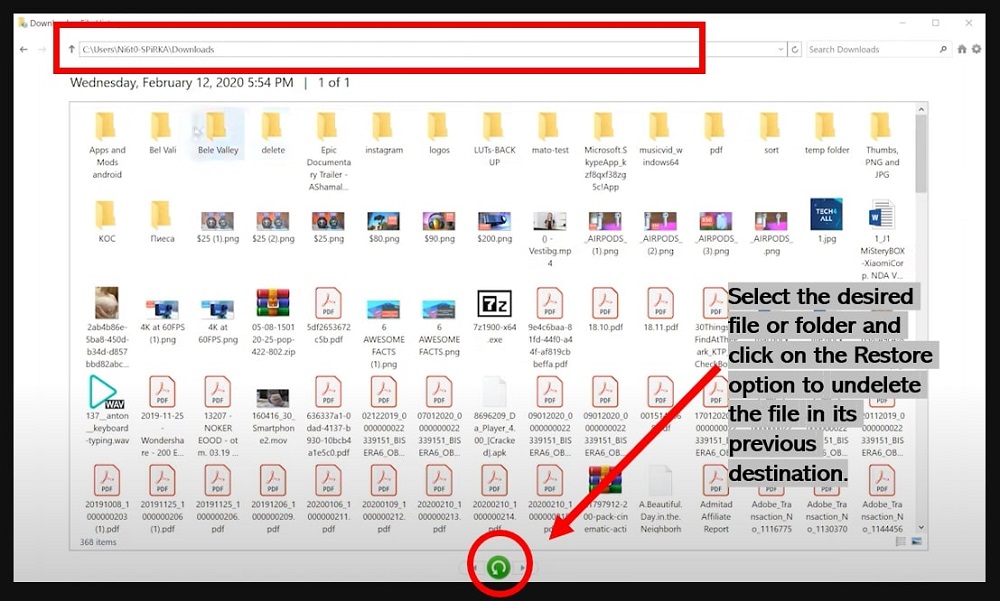Fortunately, shift deleting the files is not the end of the world. There exists: not one, not two, but multiple ways to recover the shift deleted files in Windows. Yes, without utilizing commercial software.
Read on to find how to restore permanently deleted files without software on Windows 10, 8.1, 8, 7, Vista, & XP.
Note: Before moving forward, review the contents of Recycle bin. To ascertain that you have really permanently deleted the files. Moreover, though highly impossible, retain if you have enabled cloud-backups services like One-Drive Sync or have made a copy on an external drive. Also, recall if you have attached the files to a friend or colleague, perhaps.
Is it Possible to Recover Shift Deleted Files in Windows 10?
Yes!
Contrary to popular understanding, computer hard drives, especially the disk-platter drives, do not erase the data when you command the OS to delete them. Instead, all you do is give your OS permission to overwrite the disk space previously allocated to the deleted files and make the path to those files inaccessible. Meaning, if the disk space is not overwritten, there is a good possibility that you could retrieve them.
The same statement also holds in other data-loss situations; deleted via recycle bin, partition loss, corrupted or formatted hard drive, and more scenarios.
Nonetheless, as the recovery rate depends on whether your OS has restocked the space or not — this is a time-sensitive process. You either can recover the files from a decade ago or not locate the ones deleted a few hours ago.
Method 1. Restore Permanently Deleted Files without Software Using Command Prompt
Be it a simple task like opening the Settings. Or troubleshooting system issues that even the native Windows Settings does not include an option for, Command Prompt will let you achieve almost any tasks on Windows OS; of course, including data recovery from the hard drive.
Note: If incorrectly commanded, the Command Prompt (with admin privileges) can cause irreparable damage to the existing data. Follow each step with caution, or avoid following this approach altogether.
Follow these simple instructions to learn how to restore permanently deleted files without software, i.e., using the Command Prompt:
Step 1. Hover to the Search, and type in Command Prompt.
Select Run as Administrator to initiate an elevated Command Prompt on Windows 10.
Step 2. Within the Command Prompt tab, type in the following command to examine the drive status beforehand:
chkdsk “Assigned Drive Letter:”/f
Note: In the above command: the “Assigned Drive Letter” is the drive letter, i.e., “C:” | “D:” | or “E:” or other drive letters. Additionally, the drive letter should be the one from which you have erased the data.
So, for instance, if you destroyed the data from D drive (D:), then the command to check the drive status will be:
chkdsk D: /f
In your case: the drive letter might be different — the drive that contained the deleted data. If you are unsure, you confirm the drive letter by accessing the Windows explorer.
Notice that there is no quotation mark in the command.
Press Enter to execute the command. Type in “Y” to permit CMD to scan the partition.
In the above command, “chkdsk” is a native utility to scan the filesystem on a disk (NTFS, FAT32) and ascertain the filesystem integrity beforehand (otherwise, the command to revive the permanently deleted files will not work). Combined with /f, the chkdsk corrects any logical errors in the volume’s master file table.
Note: If you utilize the command to scan the “C:” partition, Command Prompt will display a message saying: “chkdsk cannot run because the volume is in use by another process. And it will schedule the scan at the next restart.”
Still, you can proceed by typing “Y” (as indicated above) and let it run on the next restart. It will showcase the results on the Notepad when you start Windows after a shutdown or restart.
Once you see “File and Folder verification is complete,” you can proceed with the subsequent steps.
Step 3. After you see the above message, enter this command:
attrib -h -r -s /s /d drive-letter:*.*
Note: Replace the “Drive-Letter” in the above command with the name of the drive — “C” | “D” | “E” | or any other — from which you want to undelete the files.
For instance, if you want to recover the files from the “E” drive, then the command will be:
attrib -h -r -s /s /d E:*.*
You will find the recovered files in a New Folder. However, you may find them in .chk format. Simply convert the files to their original form by installing a third-party software: UnCHK. (In-house approach to do the same also exists).
Note: You may see “Access Denied” when running the above command. The reasons can be:
- You did not choose “Run as administrator” while opening the CMD.
- Any associated file may be in use.
- You may not have permission to run the Attrib command.
- Your File System or Disk may be corrupt. (Step 2 in this method ensures that the drive status is — healthy.
Of course, using Command Prompt is more complicated than other methods to recover permanently deleted files on Windows 10 without software. But remember that desperate times require desperate measures, and using the Command Prompt can be a lifesaver during adversity.
Method 2. Recover Permanently Deleted Files without Software from the Previous Version
Previous Version, integration within the volume shadow service(VSS), allows Windows OS to create a backup point, even when the files are in use. These restore points can be serviceable in the circumstances like these. Of course, the previous variant means the file may be a day old, but you will have at least something.
Note: Unfortunately, this method of retrieving permanently deleted files without software does not work across all the folders on your Windows. Moreover, it also expects a prior setup, i.e., you should have enabled the “System Protection” option within System Properties.
To check whether you have pre-enabled the features or not, follow these simple steps:
- Open Control Panel on Windows 10.
- Choose the “System & Security” option.
- On the right pane, select System.
- On the next tab, select “System Protection” on the left pane.
Under the “Protection Settings” box, you can see the specific drives for which the System Protection is ON.
Here’s how to recover permanently deleted files in Windows 10 from the Previous Version (without the software):
Step 1. Navigate to the folder that previously stored the deleted files.
Select the folder and right-click to open the context menu options. Choose the Restore Previous Version option.
If there are any restorable versions available, you will notice them in the Folder Version box. Along with that, you can also ascertain the date on which the file was last modified.
Step 2. Select the Files Versions that you want to restore. And click Restore.
Windows will show a message saying, “Are you sure you restore the previous version of {file name} from {date of previously saved version}”? Select Restore to confirm.
If there are no previous versions available, it means that the “System Protection” feature does not have any impression on that particular drive.
Of course, if that is the case — then this method will not serve you. Still, there are other ways to recover shift deleted files without software. Follow up to find one more via the File History.
Method 3. Recover Permanently Deleted Files without Software from File History
Accessible only on Windows 8 and later versions, File History constantly backs up the Documents, Music, Pictures, Videos, Offline OneDrive files, and Desktop folders. Nothing else, so if the file type belongs to these categories, this method can help you recover the shift deleted files conveniently.
Note: Like the “Previous Version” method, File History also needs a prior setup.
Follow these simple steps to learn how to recover deleted files in Windows 10 without software, i.e., from File History:
Step 1. Hover to the Search menu, and type in Restore Files.
Select Restore your files with File History.
Step 2. On the newly opened Windows, type in the name of the permanently deleted files in the address bar. You can also locate the file manually by going through all the preserved files.
- To recover a particular (or view all the versions), click on either the left or right arrow buttons.
- Select the desired file.
- Click on the “Restore” button (green toggle) to restore the file to its initial location.
Note: To save the file in a separate location:
- Right-click on the Restore toggle.
- Select the “Restore to” option.
- Assign a destination: to save the file in another location.
“File History” is your best shot at restoring the shift deleted files without any software, prominently if you utilize an SSD.
But rest easy! Even if you have not authorized this feature beforehand. There is another lifesaver — third-party recovery solutions — that can help you recover the data. Moreover, unlike the “File History” method, you will access the most recent version instead of getting your hands on the earlier backed-up file.
Bonus: The Easiest Way to Recover Permanently Deleted Files in Windows 10
If you neither have backup nor see the files in the trash, you can always rely on a commercial Windows recovery solution.
As stated, the permanently deleted files still live and breath on your hard drive. Windows may not even give you access to the files, but the third-party recovery software are your best shot at recovering the shift+delete erased files (in most cases). And while there are tons of Windows data recovery software in the market, not all are capable enough.
One that outperforms all is: Tenorshare’s 4DDiG Data Recovery for Windows.
4DDiG offers a simple-to-use interface, quick and thorough scans, and can retrieve deleted files from numerous data-loss situations, including the shift deleted files.
Long story short — you cannot go wrong with this option.
Reason to use 4DDiG Data Recovery for Windows:
- Modest interface, even the least tech-illiterates can restore their permanently deleted file without going through complex processes like CMD (given above).
- Besides restoring “shift + delete” missing files, it can also recover missing files lost due to partition, formatting, failed boot-ups, RAW, and more.
- The software costs just — US$ 45.95 (for a month) and promises 30 days money-back guarantee if it cannot recover the deleted files successfully.
- You can take assistance from Tenorshare’s technical support team by submitting an online form. You will get a definite response within 48 hours.
Need surety of recovering the accidental deletions? 4DDiG is the software for you!
FAQs About Permanently Deleted Files on Windows 10
1. What is Windows File Recovery Software on Windows 10?
Released as “Winter 2020 special”, Windows File Recovery software is only open for Windows 10 (version 2004 and later) publications.
Windows File Recovery is a command-line utility to recover accidentally deleted files from both local hard drives as well as a few external media types (USB, memory card, and flash drive). You can also employ the software to restore data even from a corrupted or formatted hard drive.
Though Microsoft has designed the software especially for NTFS file systems, you can also shift to the second signature mode to extract data from FAT, exFAT, and ReFS file systems.
2. Can I recover the shift deleted files from an SSD drive?
Yes, the “File History” (mentioned above) is often considered the sole universal method and can help you recover permanently deleted files from both an HHD or an SDD. On Windows 10, 8.1, & 8 only.
Though effective in the case of HDDs, commercial applications like 4DDiG will rarely help if you want to recover shift deleted files from an SSD. If so, it is best to evaluate the software beforehand and only then purchase.
3. Can I recover shift deleted files in Windows 10 without any software? — other options to consider
First and Foremost, you can utilize the above methods to reaccess the permanently deleted data in Windows 10.
Even if you cannot retrieve the files via the earlier mentioned methods and do not want to employ third-party applications, you can submit the hard drive to the in-lab services and leave it up to the specialists to take charge of the recovery process.
Although having the highest recovery rate, in-lab services are costly. Very costly.
4. What is the best way to recover permanently deleted files in Windows 10?
Refer — Bonus: The Easiest Way to Recover Permanently Deleted Files in Windows 10 (stated earlier).
Conclusion
Chances are one of the methods to recover shift deleted files without software must have worked for you. On the flip side, they might not have been useful altogether. As stated, two of the three methods to retrieve the shift deleted files come disabled by default. So, they will not work if you have not taken prior action. Moreover, the CMD method to rescue the files is not always productive. Still, if you insist on retaining the files without software — they are all you have got.
However, if you want to give the best shot at rescuing the permanently erased files: then 4DDiG is a one-stop Windows recovery solution. Doubt no more.
Here’s a tip before you go: Create a backup now!
